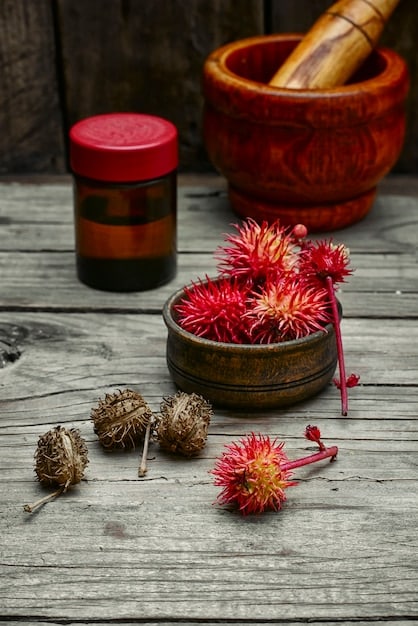Fragrance Families Explained: Your 3-Step Guide to Finding Your Signature Scent

Anúncios
Fragrance Families Explained: Find Your Signature Scent in 3 Steps reveals the secrets to understanding fragrance families, offering a straightforward guide to help you discover the perfect scent that complements your personality and style.
Anúncios
Do you find yourself overwhelmed by the sheer variety of perfumes and colognes available? Understanding **Fragrance Families Explained: Find Your Signature Scent in 3 Steps** can be the key to unlocking a world of olfactory delight and discovering scents that truly resonate with you. Let’s dive in and simplify the process.
Understanding Fragrance Families
Fragrance families are essentially categories that group perfumes and colognes based on their dominant scent characteristics. Knowing these families can greatly simplify your perfume selection process and help you articulate your personal preferences.
Anúncios
Each family has its own distinct personality, making it easier to narrow down your choices and identify the scents that best align with your taste.
Major Fragrance Families
The fragrance world is broadly divided into several major families, each with numerous sub-categories and variations. Here are some of the most prominent ones:
- Floral: Dominated by the scent of flowers, these fragrances can range from single floral notes to complex bouquets.
- Woody: Featuring notes of cedarwood, sandalwood, vetiver, and patchouli, woody fragrances are often warm and grounding.
- Oriental (or Amber): These scents are rich and exotic, often combining spices, resins, and vanilla for a luxurious feel.
- Fresh: Crisp and clean, fresh fragrances include aquatic, citrus, and green notes, evoking a sense of cleanliness and energy.
Understanding these families is the first step in finding your signature scent. Each offers a unique olfactory experience that can suit different moods and occasions.

Step 1: Identify Your Scent Preferences
Identifying your scent preferences is crucial to finding a fragrance you’ll truly love. This involves exploring different smells and understanding what appeals to you personally.
Think about the scents that evoke positive emotions and memories. Do you gravitate towards the smell of fresh flowers, or do you prefer the earthiness of a forest?
Consider Your Daily Life
Your daily life and activities can also influence your scent preferences. Someone who enjoys outdoor activities might prefer fresh, invigorating fragrances, while someone who works in a formal setting might opt for a more sophisticated, woody scent.
- Lifestyle: Consider if you lead an active lifestyle or prefer a more relaxed pace.
- Environment: Think about your work environment and social settings.
- Personal Style: Relate your scent preferences to your general style and fashion choices.
By considering these aspects, you can refine your scent preferences and narrow down your fragrance choices.
Step 2: Explore and Sample Different Fragrances
Once you have a general idea of your scent preferences, the next step is to explore and sample different fragrances. This is where the fun really begins!
Visiting perfume counters and trying out different scents can be an exciting and informative experience. Don’t hesitate to ask for recommendations from the sales associates.
Sampling Strategies
When sampling fragrances, it’s important to be methodical and avoid overwhelming your senses. Here are some tips to help you get the most out of your sampling experience:
- Start with a few: Limit yourself to sampling no more than three or four fragrances at a time.
- Use blotter strips: Spray the fragrances onto blotter strips first to get an initial impression.
- Try on your skin: If you like a scent on the blotter, try it on your skin to see how it develops over time.
- Take notes: Keep track of the fragrances you try and your initial impressions.

Step 3: Understand Fragrance Notes and Development
Understanding fragrance notes and how they develop over time is essential for making an informed decision when choosing a perfume or cologne. Every fragrance has a complex structure composed of different layers of scents.
These layers, known as notes, unfold gradually, creating a unique olfactory experience. Knowing how these notes work together can help you understand and appreciate the nuances of a fragrance.
The Fragrance Pyramid
Fragrances are often described using a pyramid structure, which illustrates how the different notes unfold over time. The pyramid consists of three main layers:
- Top Notes: These are the initial scents you perceive when you first apply a fragrance. They are usually light and fresh, designed to make a strong first impression.
- Middle Notes (Heart Notes): These notes emerge after the top notes fade and form the core of the fragrance. They are usually warmer and more complex, providing depth and character.
- Base Notes: These are the long-lasting scents that linger on the skin. They provide a foundation for the fragrance and add richness and longevity.
By understanding the fragrance pyramid, you can better predict how a fragrance will develop and whether it will suit your taste over time.
Matching Fragrances to Occasions and Seasons
The right fragrance can enhance any occasion or complement any season. Just as you might choose different outfits for different events, you can select fragrances that align with the atmosphere and mood of various settings.
Consider how a light, citrusy scent might be perfect for a summer brunch, while a warm, spicy fragrance could be ideal for a cozy winter evening.
Seasonal Selections
Different seasons call for different types of fragrances. Here are some general guidelines:
- Spring: Light and floral scents that evoke the freshness of blooming flowers.
- Summer: Fresh and aquatic fragrances that provide a cooling and invigorating effect.
- Autumn: Warm and spicy scents that capture the cozy and comforting atmosphere of fall.
- Winter: Rich and woody fragrances that provide warmth and depth during the colder months.
Experiment with different scents to find the perfect fragrance for each season and occasion. Your fragrance wardrobe can be as diverse and versatile as your clothing collection.
The Psychology of Scent
Scent has a powerful impact on our emotions and memories. The olfactory system is directly connected to the limbic system, the part of the brain responsible for processing emotions and storing memories. This connection explains why certain scents can trigger vivid recollections and strong feelings.
Choosing a fragrance that resonates with your emotions can enhance your mood and boost your confidence. Your signature scent becomes an extension of your personality, leaving a lasting impression on those around you.
Creating a Signature Scent Story
Your signature scent should tell a story about you and your unique personality. Here’s how you can create a scent story:
- Reflect on your personality: Consider your traits, interests, and aspirations.
- Identify scent families that resonate: Choose fragrance families that align with your personality.
- Experiment with different notes: Explore individual notes and combinations to create a unique blend.
- Test the longevity and sillage: Ensure the fragrance lasts and projects well.
Caring for Your Fragrance Collection
Properly caring for your fragrance collection can extend the lifespan of your perfumes and colognes, ensuring they maintain their original scent profiles. Exposure to light, heat, and humidity can degrade the quality of fragrances, causing them to lose their vibrancy and complexity.
Storing your fragrances in a cool, dark, and dry place can help preserve their integrity. A drawer or cabinet away from direct sunlight is an ideal storage location.
Storage Tips
Here are some practical tips for caring for your fragrance collection:
- Keep away from sunlight: Store fragrances in a dark place to prevent degradation.
- Avoid temperature fluctuations: Maintain a consistent temperature to preserve the scent profile.
- Seal tightly: Ensure the bottle is tightly sealed to prevent evaporation.
- Store upright: Keep bottles upright to avoid leakage and maintain the integrity of the sprayer.
| Key Point | Brief Description |
|---|---|
| 👃 Fragrance Families | Groups scents by dominant characteristics like floral, woody, and oriental. |
| 🌸 Scent Preferences | Consider your lifestyle and emotional connections to identify your favourite aromas. |
| 🧪 Sampling Strategies | Use blotter strips, test on skin, and take notes to properly evaluate fragrances. |
| 🕰️ Fragrance Notes | Understanding top, middle, and base notes helps appreciate how a scent evolves. |
Frequently Asked Questions
▼
The main fragrance families include floral, woody, oriental (or amber), and fresh. Each family has distinct characteristics that appeal to different preferences and occasions.
▼
Consider your daily life, personal style, and the scents that evoke positive emotions. Sampling different fragrances and noting your reactions can help you identify your preferences.
▼
Fragrance notes are the layers of scents that unfold over time, including top notes (initial scents), middle notes (heart), and base notes (long-lasting foundation). Understanding them allows you to appreciate a fragrance’s evolution.
▼
Store fragrances in a cool, dark, and dry place away from direct sunlight and temperature fluctuations to preserve their integrity. Ensure bottles are tightly sealed to prevent evaporation.
▼
Yes, scent has a powerful impact on emotions and memories due to its direct connection to the limbic system. Choosing a fragrance that resonates with your emotions can enhance your mood and boost your confidence.
Conclusion
Embarking on a journey to discover your signature scent is an exciting and personal experience. By understanding fragrance families, identifying your preferences, and exploring different notes, you can find the perfect fragrance that complements your style and enhances your confidence. Happy scent hunting!






